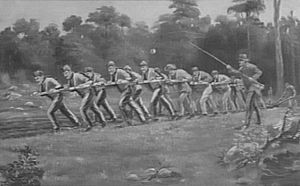Australian Convict Sites facts for kids
| UNESCO World Heritage Site | |
|---|---|

View of Port Arthur, Tasmania one of the 11 penal sites constituting the Australian Convict Sites
|
|
| Location | Australia |
| Criteria | Cultural: (iv), (vi) |
| Inscription | 2010 (34th Session) |
| Area | 1,502.51 ha (3,712.8 acres) |
| Buffer zone | 3,746.68 ha (9,258.2 acres) |
The Australian Convict Sites are a special group of 11 historic places in Australia. These sites were once prisons or places where prisoners, called convicts, lived and worked. They are now recognized as a World Heritage Site by UNESCO.
From 1788 onwards, the British government sent thousands of convicts from England to Australia. This was a way to deal with crowded prisons in Britain. This system of moving prisoners lasted for about 80 years.
The 11 sites show how this large-scale movement of people happened. They also show how European countries expanded their power using the labor of these convicts. These sites are found in Sydney, Tasmania, Norfolk Island, and Fremantle.
All these places were first added to the Australian National Heritage List. Later, they were chosen to be part of the World Heritage list.
Contents
Exploring the Convict Sites
There are 11 important places that make up the Australian Convict Sites World Heritage property. Each one tells a part of the story of convict life in Australia.
- Cockatoo Island Convict Site (New South Wales)
- Great North Road (New South Wales)
- Hyde Park Barracks (New South Wales)
- Old Government House (New South Wales)
- Kingston and Arthurs Vale Historic Area (Norfolk Island)
- Brickendon and Woolmers Estates (Tasmania)
- Cascades Female Factory (Tasmania)
- Coal Mines Historic Site (Tasmania)
- Darlington Probation Station (Tasmania)
- Port Arthur (Tasmania)
- Fremantle Prison (Western Australia)
Why These Sites Are Important
Australia has over 3,000 places connected to its convict past. The 11 Australian Convict Sites were chosen because they are the best examples of this period in history. They meet two important rules for becoming a World Heritage Site. These are called World Heritage Selection Criteria IV and VI.
Criterion IV: A Unique Part of History
This rule means a site shows an important stage in human history. The Australian Convict Sites are a great example of the forced movement of convicts. This was a big part of how societies changed and developed.
Criterion VI: Global Ideas and Changes
This rule means a site is linked to events or ideas that are important to the whole world. The convict sites show how people thought about crime and punishment during a time of big changes. This period is known as the Age of Enlightenment and the modern era.
See Also
 In Spanish: Sitios australianos de presidios para niños
In Spanish: Sitios australianos de presidios para niños


